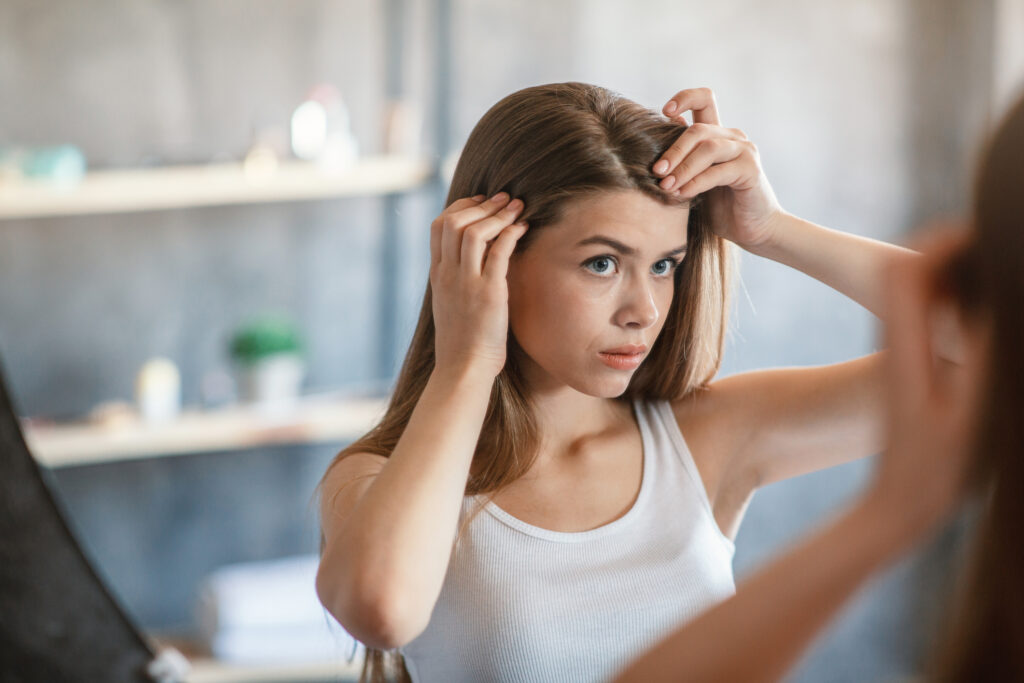What’s going on with my scalp?

If you are like most of us, your scalp is a bit of a mystery. Hidden away under your hair, it sort of does its own thing, and you don’t really notice it or even think about it until it suddenly calls itself to your attention by itching, flaking, or doing something else unpleasant. In many cases, it’s hard to even know what’s going on with it! Here, we look at some common scalp issues and give you some solutions to help you manage your scalp.
- Scalp build-up can cause your scalp to itch and cause, and can mimic other conditions. Sometimes, it can cause symptoms that are similar to those of seborrheic dermatitis, scalp psoriasis, and eczema, but it is not actually a medical condition. Rather, it is the result of different substances sticking to the scalp and building up over time. Shampoos, conditioners, styling creams and gels, foams, oils, and ointments can all cause build-up. Sometimes, you can have a build-up of naturally produced substances too, like sweat, sebum (oil), and dead skin cells. Fortunately, you can treat and prevent build-up at home. Limit the use of unnecessary hair products, and brush your hair frequently, to prevent the hair from tangling and to help break up substances that might otherwise build up. You might also want to consider an exfoliator on the scalp for the same reason. The best course of action, though, is to choose the right shampoo and conditioner for your hair type and wash your hair regularly. If you have oily hair, you probably need to wash it every day, and people with dry hair should go no more than a few days without washing.
- Itching or tingling maybe caused by an allergic reaction. If you’ve recently switched shampoos or other hair products, it may be easy to spot the cause. If you can’t figure it out on your own, though, you may need to consult with your dermatologist and have some allergy testing done to help you determine what is causing the problem.
- Psoriasis affects one to two percent of the population. According to the National Psoriasis Foundation, while psoriasis can affect any part of the body, about 45 to 56 percent of people with psoriasis have it on their scalp. It looks like pink or purple plaques with silvery scales that can itch, hurt, crust, and bleed. Thought to be an immune dysregulation around the skin cells, psoriasis can be made worse by stress. It can be treated with topical steroids, injections to suppress the flare-ups, or an excimer laser to address individual spots that are not getting better. Dialing down your hair routine can help, too; sometimes shampooing less often lessens the occurrence of rashes.
- Ringworm is not really a worm, but a fungal infection. It is contagious and affects children more frequently than adults, but adults can get it. Typically painful and scaly, the rash has a circular shape and can cause enlarged lymph nodes. Untreated, it can lead to bald spots, broken hairs, and black dots, and can be caused by direct or indirect contact. It can be treated with four to six weeks of antifungal medication, and is no longer contagious 48 hours after treatment begins.
- Seborrheic Dermatitis is one of the most common scalp conditions. If you’ve ever seen a baby with cradle cap, that’s an example of seborrheic dermatitis. In adults, this condition presents as red, itchy patches with greasy scale or dandruff. It can be triggered by things like stress or a change in seasons, and if left to spread, it can affect the face, nose, eyebrows, ears, and chest, and in some cases can cause complications like hair loss. Though there is some debate, it is thought to be caused by a yeast called Malassezia, and is more likely to occur in those with Parkinson’s disease, depression, diabetes, obesity, or a weakened immune system. It can be treated with prescription strength shampoo or a topical steroid.
- Folliculitis is essentially inflammation of the hair follicle. It looks like little pus bumps, similar to acne, and these bumps may feel sore. It can be caused by a bacterial or fungal infection, or from irritation caused by shaving, hair dyes, or excessive sweating. It is wise to see a dermatologist for this, because your doctor can determine whether you need antibiotics or just anti-inflammatory medications.
When you need help with your skin, whether on your face, body, or scalp, Swinyer-Woseth Dermatology is here to help. We are committed to providing superior, professional skin care, in a manner that’s practical, efficient, and compassionate. With over 30 years of experience providing dermatological services in Salt Lake City, we provide a variety of services, from cosmetic skincare to treatment for skin cancer. Our team of board-certified dermatologists and licensed cosmetic service providers are here to provide you the care you need in a comfortable, professional atmosphere. Call (801) 682-4715 or contact us through our website.
